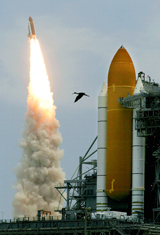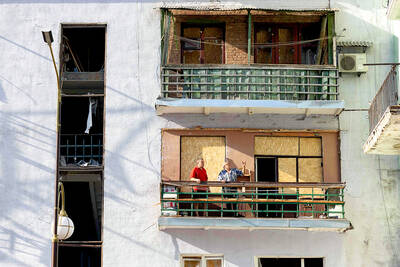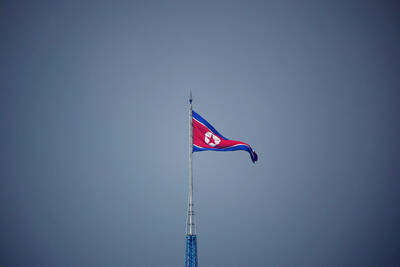Atlantisblasted off on Monday for the Hubble Space Telescope on the most delicate and dangerous repair job ever in orbit — a mission so risky that for the first time a second shuttle stands ready to rescue the seven astronauts if something goes wrong.
It will be the last visit to the aging observatory, and the work will include five spacewalks in an especially high orbit strewn with space junk. The astronauts will try to fix equipment that was never designed to be tinkered with in space, and they will not have the option of using the International Space Station as a safe harbor in a crisis.
The improvements will extend the life of one of the space program’s proudest achievements — a technological marvel that has yielded breathtaking pictures of distant galaxies and some of the celestial violence that shaped the universe.

PHOTO: REUTERS
“I have full confidence that they’ll pull off a success and if they do, we’ll have a Hubble for at least five, six, eight years more,” said Ed Weiler, NASA’s science mission chief.
The crew will replace Hubble’s batteries and gyroscopes, install two cameras and take a crack at fixing two broken science instruments.
Mission Control wasted no time informing the astronauts that an early look at the launch video had uncovered nothing of concern.
Some debris was spotted coming off the fuel tank, but nothing appeared to strike Atlantis. The astronauts inspected the thermal shielding on their crew cabin on Monday evening; a full-scale survey of the shuttle was set for yesterday.
Hubble was passing almost directly overhead as Atlantis rocketed off its launch pad for the 11-day flight. When the telescope broke down last year, NASA postponed the mission seven months to devise additional repairs.
“At this point, all I’ve got left to say is, ‘Let’s launch Atlantis,’” commander Scott Altman said just before liftoff.
“Enjoy the ride, pal,” launch director Mike Leinbach replied.
Thirty-thousand people packed the launch site, eager to see NASA’s fifth and final send-off to the 19-year-old Hubble.
Scientists had mixed emotions as they watched Atlantis climb into the sky.
“We have 60 years of Hubble between us,” said Weiler, his arm around senior project scientist David Leckrone. “It’s bittersweet ... I know this one is the last one. On the other hand, I know that Hubble is going to be better than ever once the astronauts do their thing.”
Leckrone was also wistful: “It’s the end of the era of Hubble servicing.”
Hubble is way overdue for a tuneup.
But the stakes, as well as the dangers, are higher since astronauts last visited in 2002. Space has become more littered with junk at Hubble’s altitude because of satellite collisions and breakups, and NASA now knows all too well how much damage can be done at liftoff by a piece of fuel-tank foam. Columbia was brought down by such a blow.
Astronauts will also remove the science data-handling unit that failed in September and had to be revived, and put in an old spare that was hustled into operation. Fresh insulating covers will be added to the outside of the telescope and a new fine guidance sensor for pointing will be hooked up.
The work is so tricky and intricate that two of the repairmen are Hubble veterans, John Grunsfeld and Michael Massimino. Grunsfeld, the chief repairman, is making a record-breaking third trip to the telescope. Altman, the commander, also has flown to Hubble before.
All told, it’s a US$1 billion mission. The space telescope, over the decades, represents a US$10 billion investment. It was launched amid considerable hoopla in 1990, but quickly found to be nearsighted, producing blurred images, because of a flawed mirror.
Corrective lenses were installed in 1993 during what Weiler calls “the miracle in space mission.” The results were stunning and included the acclaimed “pillars of creation” image of Eagle Nebula, a star-forming region 6,500 light years away.
The new cameras should enable Hubble to peer even deeper into the cosmos and collect an unprecedented amount of data.
NASA canceled the mission in 2004, a year after the Columbia tragedy, saying it was too dangerous because Atlantis would not be able to get to the space station, which is in another orbit.
The mission was reinstated two years later by the space agency’s new boss, but only after shuttle flights had resumed and repair techniques had been developed. As an added precaution, another shuttle was ordered to be on standby, in case Atlantis suffered irreparable damage.
If an emergency arises, Endeavour is ready to lift off in as little as three days to save the six men and one woman aboard Atlantis. Endeavour will remain on standby until Atlantis heads back home on May 22.
This is the last time a shuttle flies somewhere other than the space station, and NASA does not expect to have shuttles on both pads again.

‘HYANGDO’: A South Korean lawmaker said there was no credible evidence to support rumors that Kim Jong-un has a son with a disability or who is studying abroad South Korea’s spy agency yesterday said that North Korean leader Kim Jong-un’s daughter, Kim Ju-ae, who last week accompanied him on a high-profile visit to Beijing, is understood to be his recognized successor. The teenager drew global attention when she made her first official overseas trip with her father, as he met with Chinese President Xi Jinping (習近平) and Russian President Vladimir Putin. Analysts have long seen her as Kim’s likely successor, although some have suggested she has an older brother who is being secretly groomed as the next leader. The South Korean National Intelligence Service (NIS) “assesses that she [Kim Ju-ae]

In the week before his fatal shooting, right-wing US political activist Charlie Kirk cheered the boom of conservative young men in South Korea and warned about a “globalist menace” in Tokyo on his first speaking tour of Asia. Kirk, 31, who helped amplify US President Donald Trump’s agenda to young voters with often inflammatory rhetoric focused on issues such as gender and immigration, was shot in the neck on Wednesday at a speaking event at a Utah university. In Seoul on Friday last week, he spoke about how he “brought Trump to victory,” while addressing Build Up Korea 2025, a conservative conference

DEADLOCK: Putin has vowed to continue fighting unless Ukraine cedes more land, while talks have been paused with no immediate results expected, the Kremlin said Russia on Friday said that peace talks with Kyiv were on “pause” as Ukrainian President Volodymyr Zelenskiy warned that Russian President Vladimir Putin still wanted to capture the whole of Ukraine. Meanwhile, US President Donald Trump said that he was running out of patience with Putin, and the NATO alliance said it would bolster its eastern front after Russian drones were shot down in Polish airspace this week. The latest blow to faltering diplomacy came as Russia’s army staged major military drills with its key ally Belarus. Despite Trump forcing the warring sides to hold direct talks and hosting Putin in Alaska, there

North Korea has executed people for watching or distributing foreign television shows, including popular South Korean dramas, as part of an intensifying crackdown on personal freedoms, a UN human rights report said on Friday. Surveillance has grown more pervasive since 2014 with the help of new technologies, while punishments have become harsher — including the introduction of the death penalty for offences such as sharing foreign TV dramas, the report said. The curbs make North Korea the most restrictive country in the world, said the 14-page UN report, which was based on interviews with more than 300 witnesses and victims who had